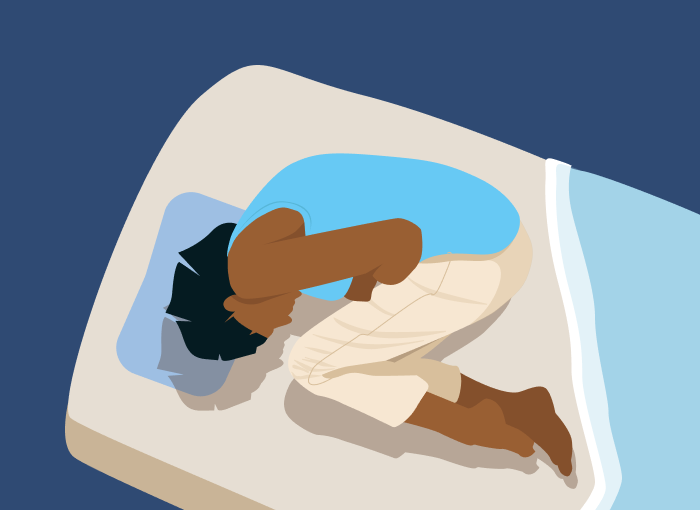Do you find yourself instinctively curling up in bed, lying on your side with bent elbows and knees tucked up toward your chest? As it turns out, this is a popular sleeping position, with around 47% of people in the U.S. choosing to sleep this way, per a survey conducted by the Better Sleep Council (BSC).
Because it mimics the position of a fetus in the womb, curling up in bed is more commonly known as the fetal sleeping position. But besides being popular, the fetal position also has a significant impact on the quality of your sleep, just like any other sleeping position.
The position in which one sleeps can have a significant impact on factors such as comfort, spinal alignment, and even breathing patterns, all of which contribute to overall sleep quality.
Oura members can consult their Sleep Score each morning to gain crucial insights about their sleep quality and how to improve it.
Below, we explore the fetal sleep position — including who should sleep this way, benefits and drawbacks, and how to optimize sleeping in the position.
RELATED: Restless Sleep? How to Reduce Tossing and Turning at Night
Who should sleep in the fetal position?
The BSC survey revealed that women are more likely to sleep in the fetal position than men, but anyone can sleep in the fetal position. That said, some people may benefit more from curling up in bed than others.
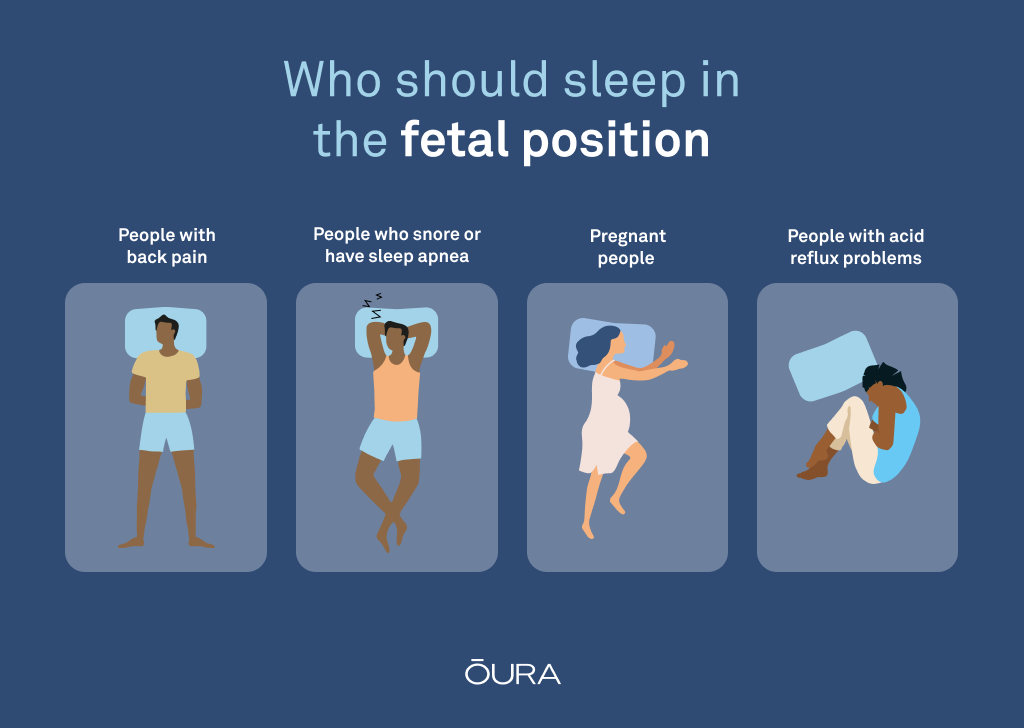
People with back pain
Sleeping on your side has been shown to reduce back pain. This is because lying on your side helps to keep proper spinal alignment and it provides protection against spinal symptoms that can lead to lower back pain. Curling up in a fetal position can also alleviate lower back pain from a herniated disc because it minimizes the bending of the spine and opens up the joints.
People who snore or have sleep apnea
Snoring, whether caused by sleep apnea or not (known as non-apneic snoring), occurs when the tongue and soft tissue in the airway collapse towards the back of the throat, leading to a partially or fully blocked airway.
Curling up in bed, or sleeping in the fetal position, helps to open up the airway, which can improve breathing, reduce snoring, and improve sleep quality. In fact, studies have found that sleeping on your side when you have mild to moderate sleep apnea is effective in reducing symptoms such as disruptive breathing.
READ MORE: Can You Snore With Your Mouth Closed? How Mouth Tape Impacts Snoring
Pregnant people
Sleeping in the fetal position can be beneficial for pregnant people, particularly those in the late stages of pregnancy. For one, curling up in bed takes pressure off the back, plus it reduces pressure on the heart.
However, not all side sleeping is equal during pregnancy. Research suggests that it may be better to sleep on the left side when expecting since this improves blood circulation to the developing baby and prevents the uterus from pressing against the liver and kidneys.
People with acid reflux
For people who experience acid reflux, sleeping in the wrong position can allow stomach acids to slip into the esophagus, resulting in pain and discomfort that makes it difficult to fall asleep.
Sleeping on your side, including in the fetal position, can help relieve symptoms of acid reflux. However, you have to sleep on the correct side to reap the benefits. Studies have found that sleeping on your right side can aggravate acid reflux while sleeping on the left can help calm symptoms.
Besides increasing comfort levels, sleeping in the fetal position also offers other benefits that help improve sleep quality.
Additional benefits of curling up in bed
Sleeping in the fetal position helps to decrease stress and anxiety, promote relaxation, and reduce sleep disturbances.
It’s a natural response to stress and anxiety
According to Psychology Today, assuming the fetal position appears to be soothing and reassuring. As such, the fetal sleeping position may be beneficial for people who experience anxiety, helping them to feel more relaxed and less anxious compared to when they sleep in other positions.
One explanation for this may be that our bodies tense up when we are anxious or stressed, but the fetal sleeping position, which is one of the most familiar positions to humans, mimics the security and comfort of the womb, making it easier to relax and fall asleep.
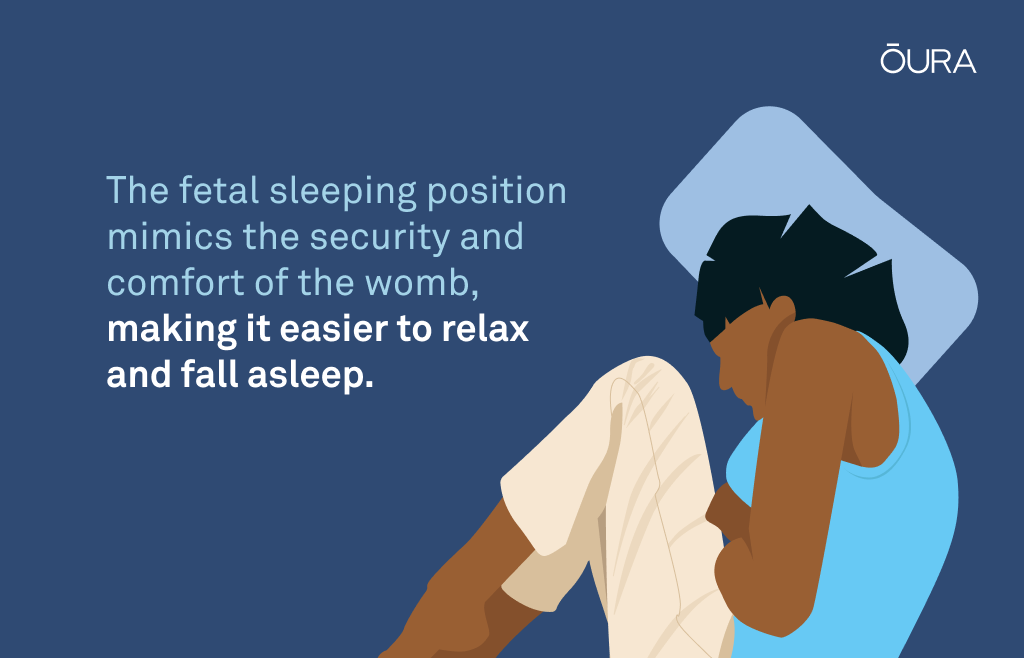
It minimizes sleep disturbances
Since it reduces snoring and alleviates obstructive sleep apnea symptoms, sleeping in the fetal position minimizes sleep disturbances for people who have bed partners. Sleep disturbances are especially important to avoid because they have been shown to have a negative impact on relationship quality.
Is it bad to sleep in the fetal position?
Despite the numerous benefits, curling up in bed also comes with some drawbacks:
Increased pressure on body organs
Sleeping in the fetal position improves circulation for many people, but there is some evidence that sleeping on your left side can increase pressure on the chest cavity and heart for some people. This can negatively affect blood flow and heart rate. One study has even suggested that people with congestive heart failure should avoid sleeping on their left side for this reason.
Being tightly curled with one’s knees pulled towards the chest can also put pressure on the diaphragm and lungs, causing breathing difficulties and decreased oxygen flow. This can lead to discomfort and possible health complications, especially for those with pre-existing breathing issues.
The good news is that you can monitor your heart and breathing rates and take steps to eliminate any factors that may be affecting them. Oura members, for example, can measure their heart rate variability (HRV) and respiratory rate to gain insight into how factors such as their behavior and environment impact their bodily functions.
Increased likelihood of muscle cramps and discomfort
Spending the whole night curled up in the fetal position can cause tension in the legs, knees, and hips, leading to cramping, discomfort, and even pain. This can disrupt sleep and affect the overall quality of rest.
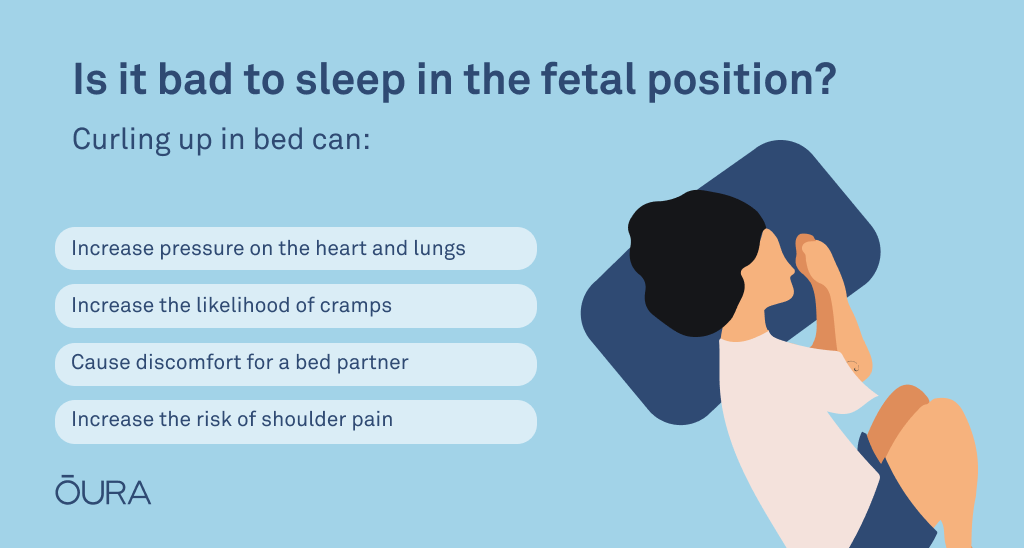
Discomfort for bed partners
Sleeping in the fetal position can be uncomfortable for partners, especially if the person in the fetal position takes up too much space or tosses and turns during sleep. This can cause inconvenience and disruption to both partners’ sleep quality.
RELATED: What Is a Sleep Divorce?
Increased risk of shoulder pain
Sleeping in the fetal position may not be the best option for people who have shoulder pain. One study discovered that patients with shoulder pain on one side were more likely to sleep on the painful side than on the pain-free side, thereby worsening their pain.
Tips for improving your sleep in the fetal sleeping position
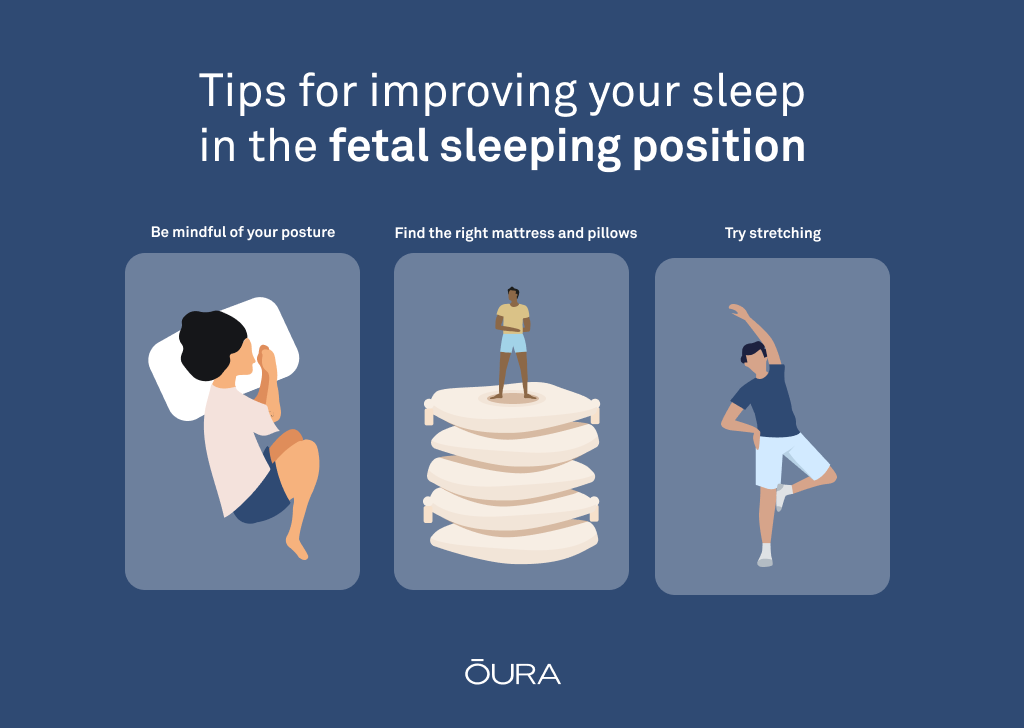
1. Be mindful of your posture
To achieve proper spinal alignment and make the fetal position more comfortable, maintain proper posture and ensure that you’re relaxed when you curl up. This includes keeping the neck and head in alignment with the rest of the body and avoiding positions that could strain the neck or back.
Furthermore, try to extend at least one leg during the night to relieve the tension caused by being too tightly curled up.
2. Find the right mattress and pillows
A firm and supportive mattress will help to maintain proper spinal alignment, while a soft pillow will provide cushioning for the head and neck. It’s also a good idea to use a body pillow or another pillow to support the knees and legs. This can help relieve any unnatural pressure on your lower spine and hips, as well as any cramps and discomfort that may occur.
READ MORE: How to Choose the Best Bedding for a Better Night’s Sleep
3. Try stretching before bed
Stretching before bed can help prevent and relieve muscle cramps and discomfort, which can be especially problematic if you sleep in a tightly curled position and rarely stretch during the night. Simple exercises, such as stretching the legs, calves, and feet, can help improve circulation and flexibility while also preventing cramping.
The winning combination: The right sleeping position, sleep hygiene, and good sleep habits
Although the fetal position is popular, a sleeping position is only as good as your sleep hygiene and habits. Good sleep hygiene and habits can greatly improve overall sleep quality, regardless of sleep position. So, in addition to finding a sleeping position that best serves your health, it’s important to think about sleep hygiene and how you can incorporate good habits into your bedtime routine.
This includes establishing a consistent sleep schedule, avoiding caffeine and alcohol before bedtime, and creating a relaxing bedtime routine. It’s also vital to avoid screens and other sources of blue light for at least an hour before bed, as exposure to blue light can disrupt natural sleep patterns.
Oura members can use Tags to understand how certain sleep habits and practices may be affecting their sleep quality and overall wellness.
RELATED: Try Oura’s Guided Sleep Meditations for Deep and Restful Sleep




